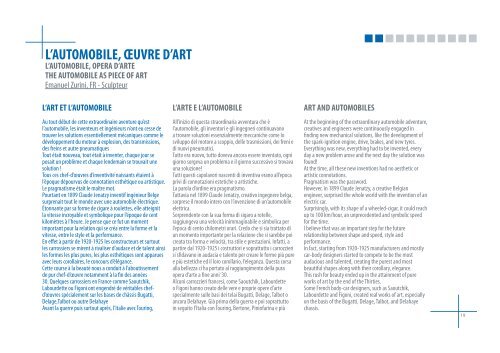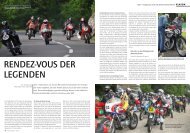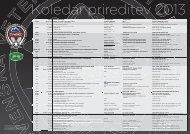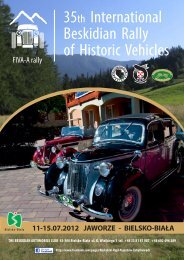Automotoclub Storico Italiano - Fédération Internationale des ...
Automotoclub Storico Italiano - Fédération Internationale des ...
Automotoclub Storico Italiano - Fédération Internationale des ...
You also want an ePaper? Increase the reach of your titles
YUMPU automatically turns print PDFs into web optimized ePapers that Google loves.
L’AUTOMOBILE, ŒUVRE D’ART<br />
L’AUTOMOBILE, OPERA D’ARTE<br />
THE AUTOMOBILE AS PIECE OF ART<br />
Emanuel Zurini, FR - Sculpteur<br />
L’ART ET L’AUTOMOBILE<br />
Au tout début de cette extraordinaire aventure qu’est<br />
l’automobile, les inventeurs et ingénieurs n’ont eu cesse de<br />
trouver les solutions essentiellement mécaniques comme le<br />
développement du moteur à explosion, <strong>des</strong> transmissions,<br />
<strong>des</strong> freins et autre pneumatiques<br />
Tout était nouveau, tout était à inventer, chaque jour se<br />
posait un problème et chaque lendemain se trouvait une<br />
solution !<br />
Tous ces chef-d’œuvres d’inventivité naissants étaient à<br />
l’époque dépourvus de connotation esthétique ou artistique.<br />
Le pragmatisme était le maître mot.<br />
Pourtant en 1899 Claude Jenatzy inventif ingénieur Belge<br />
surprenait tout le monde avec une automobile électrique.<br />
Étonnante par sa forme de cigare à roulettes, elle atteignit<br />
la vitesse incroyable et symbolique pour l’époque de cent<br />
kilomètres à l’heure. Je pense que ce fut un moment<br />
important pour la relation qui se créa entre la forme et la<br />
vitesse, entre le style et la performance.<br />
En eff et à partir de 1920-1925 les constructeurs et surtout<br />
les carrossiers se mirent à rivaliser d’audace et de talent ainsi<br />
les formes les plus pures, les plus esthétiques sont apparues<br />
avec leurs corollaires, le concours d’élégance.<br />
Cette course à la beauté nous a conduit à l’aboutissement<br />
de pur chef-d’œuvre notamment à la fi n <strong>des</strong> années<br />
30. Quelques carrossiers en France comme Saoutchik,<br />
Labourdette ou Figoni ont engendré de véritables chefd’œuvres<br />
spécialement sur les bases de châssis Bugatti,<br />
Delage,Talbot ou autre Delahaye<br />
Avant la guerre puis surtout après, l’Italie avec Touring,<br />
L’ARTE E L’AUTOMOBILE<br />
All’inizio di questa straordinaria avventura che è<br />
l’automobile, gli inventori e gli ingegneri continuavano<br />
a trovare soluzioni essenzialmente meccaniche come lo<br />
sviluppo del motore a scoppio, delle trasmissioni, dei freni e<br />
di nuovi pneumatici.<br />
Tutto era nuovo, tutto doveva ancora essere inventato, ogni<br />
giorno sorgeva un problema e il giorno successivo si trovava<br />
una soluzione!<br />
Tutti questi capolavori nascenti di inventiva erano all’epoca<br />
privi di connotazioni estetiche o artistiche.<br />
La parola d’ordine era pragmatismo.<br />
Tuttavia nel 1899 Claude Jenatzy, creativo ingegnere belga,<br />
sorprese il mondo intero con l’invenzione di un’automobile<br />
elettrica.<br />
Sorprendente con la sua forma di sigaro a rotelle,<br />
raggiungeva una velocità inimmaginabile e simbolica per<br />
l’epoca di cento chilometri orari. Credo che si sia trattato di<br />
un momento importante per la relazione che si sarebbe poi<br />
creata tra forma e velocità, tra stile e prestazioni. Infatti, a<br />
partire dal 1920-1925 i costruttori e soprattutto i carrozzieri<br />
si sfi davano in audacia e talento per creare le forme più pure<br />
e più estetiche ed il loro corollario, l’eleganza. Questa corsa<br />
alla bellezza ci ha portato al raggiungimento della pura<br />
opera d’arte a fi ne anni ‘30.<br />
Alcuni carrozzieri francesi, come Saoutchik, Labourdette<br />
o Figoni hanno creato delle vere e proprie opere d’arte<br />
specialmente sulle basi dei telai Bugatti, Delage, Talbot o<br />
ancora Delahaye. Già prima della guerra e poi soprattutto<br />
in seguito l’Italia con Touring, Bertone, Pininfarina e più<br />
ART AND AUTOMOBILES<br />
At the beginning of the extraordinary automobile adventure,<br />
creatives and engineers were continuously engaged in<br />
fi nding new mechanical solutions, like the development of<br />
the spark-ignition engine, drive, brakes, and new tyres.<br />
Everything was new, everything had to be invented, every<br />
day a new problem arose and the next day the solution was<br />
found!<br />
At the time, all these new inventions had no aesthetic or<br />
artistic connotations.<br />
Pragmatism was the password.<br />
However, in 1899 Claude Jenatzy, a creative Belgian<br />
engineer, surprised the whole world with the invention of an<br />
electric car.<br />
Surprisingly, with its shape of a wheeled-cigar, it could reach<br />
up to 100 km/hour, an unprecedented and symbolic speed<br />
for the time.<br />
I believe that was an important step for the future<br />
relationship between shape and speed, style and<br />
performance.<br />
In fact, starting from 1920-1925 manufacturers and mostly<br />
car-body <strong>des</strong>igners started to compete to be the most<br />
audacious and talented, creating the purest and most<br />
beautiful shapes along with their corollary, elegance.<br />
This rush for beauty ended up in the attainment of pure<br />
works of art by the end of the Thirties.<br />
Some French body-car <strong>des</strong>igners, such as Saoutchik,<br />
Labourdette and Figoni, created real works of art, especially<br />
on the basis of the Bugatti, Delage, Talbot, and Delahaye<br />
chassis.<br />
19








